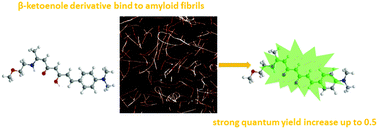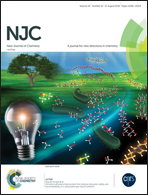Design of functionalized β-ketoenole derivatives as efficient fluorescent dyes for detection of amyloid fibrils†
Abstract
The self-association of proteins into insoluble filamentous aggregates – amyloid fibrils – is associated with a range of protein deposition disorders. With the aim of developing fluorescent probes sensitive to amyloid aggregates, a new series of derivatives of (2Z,5Z,7E)-6-hydroxy-2-(alkylamino)-8-arylocta-2,5,7-trien-4-one dyes was synthesized. These dyes are less sensitive to native amyloidogenic proteins, such as insulin or lysozyme, while they have the ability to exhibit a pronounced fluorescence response in the presence of amyloid fibrils of these proteins depending on the structure of the dye tail groups. The dyes associated with the fibrils show green-yellow emission (495–540 nm) and rather large Stokes shift values (68–125 nm). Upon binding to the fibrils, the fluorescence quantum yields of the dyes could increase by a hundred times up to 0.18–0.47, and the fluorescence intensity decay time strongly enhances up to 0.9–1.3 ns. These features make ketoenoles attractive as probes for the detection of amyloid fibrils; besides, the efficiency of these dyes for real-time monitoring of the kinetics of protein aggregation is shown. The best sensing properties were shown by dyes 2 and 9 bearing short amino tail groups (correspondingly 2-methoxyethyl and 2-hydroxyethyl) and a 4-substituted phenyl moiety at the other end of the ketoenole backbone.



 Please wait while we load your content...
Please wait while we load your content...